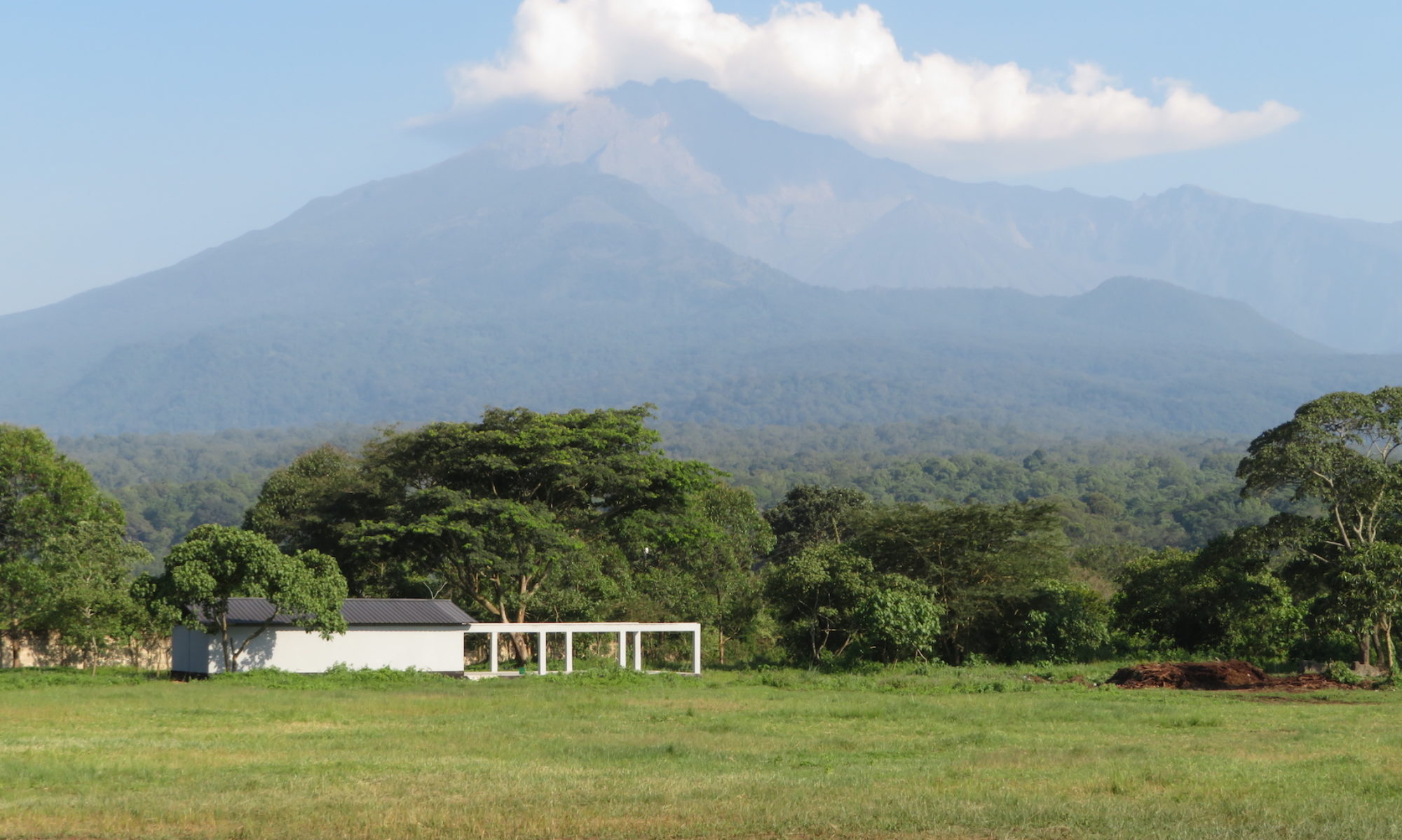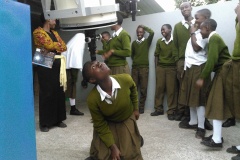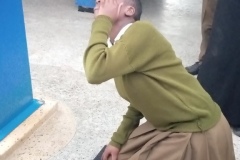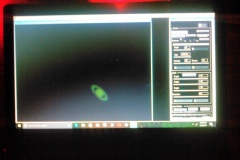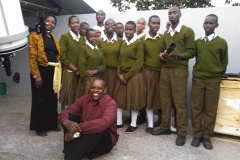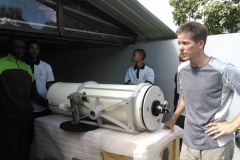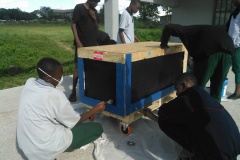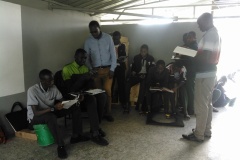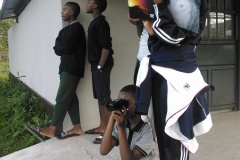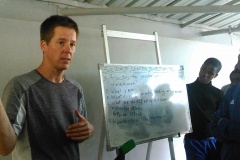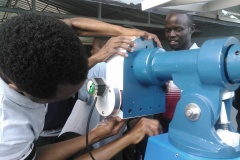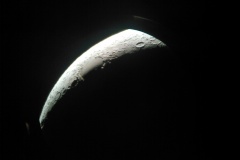Today we discovered the reason why we have play (“slop”) in the RA axis. The friction clutch has four through-holes that pass four bolts from the outer most plate through the large RA gear and to a fixed back plane attached to the RA armature. Springs provide the tension. The through-holes are a bit too large. So when RA motion is engaged, <1mm on the plate translates to ~5mm travel at the telescope before a solid connection is made. While this does not affect the guided function of the RA motor, it makes for frustrating manual centering. We went to Usa River to try and find a thin sleeve or bushing, but came back empty handed. We will take the outer clutch plate to the Arusha Technical University and use their mill to prepare a more sophisticate interface between the plates to eliminate the RA axis play.
Roll out the red carpet!
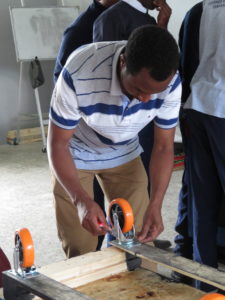 Yesterday saw the attachment of new red carpet to the top of the two mobile work benches (built from the shipping crates) and the “carpeting” of the computer workstation too. The observatory is really coming together –looking so smart! with intent to seal the floor this weekend with an epoxy finish.
Yesterday saw the attachment of new red carpet to the top of the two mobile work benches (built from the shipping crates) and the “carpeting” of the computer workstation too. The observatory is really coming together –looking so smart! with intent to seal the floor this weekend with an epoxy finish.
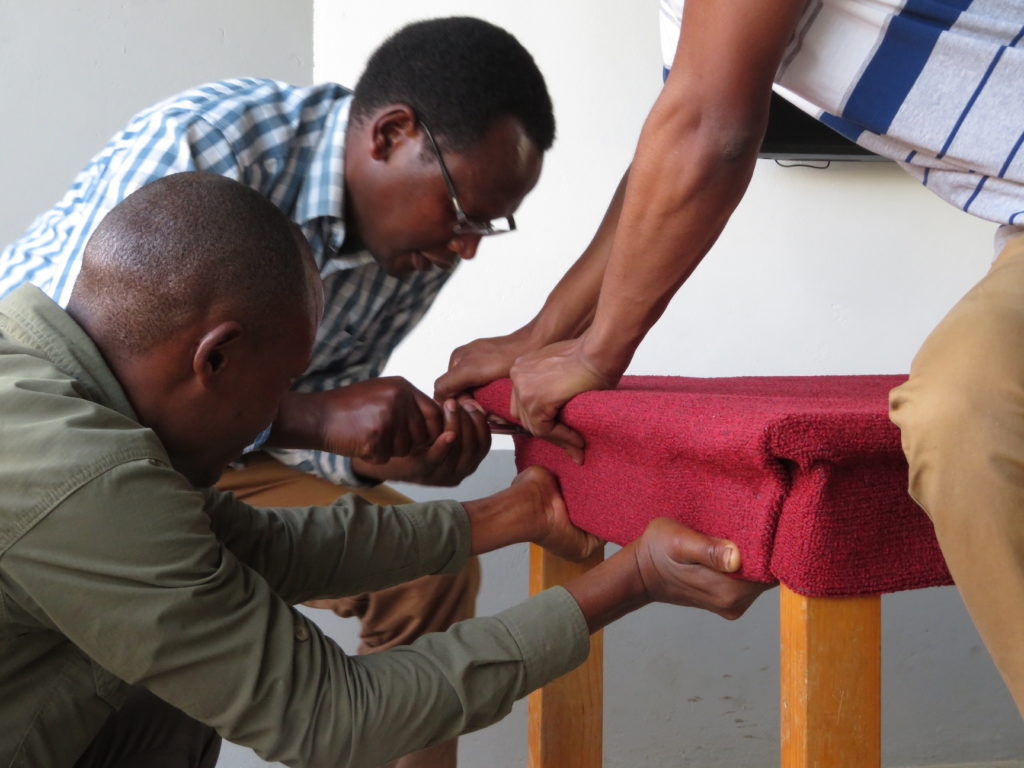
COSMOS, Episode I
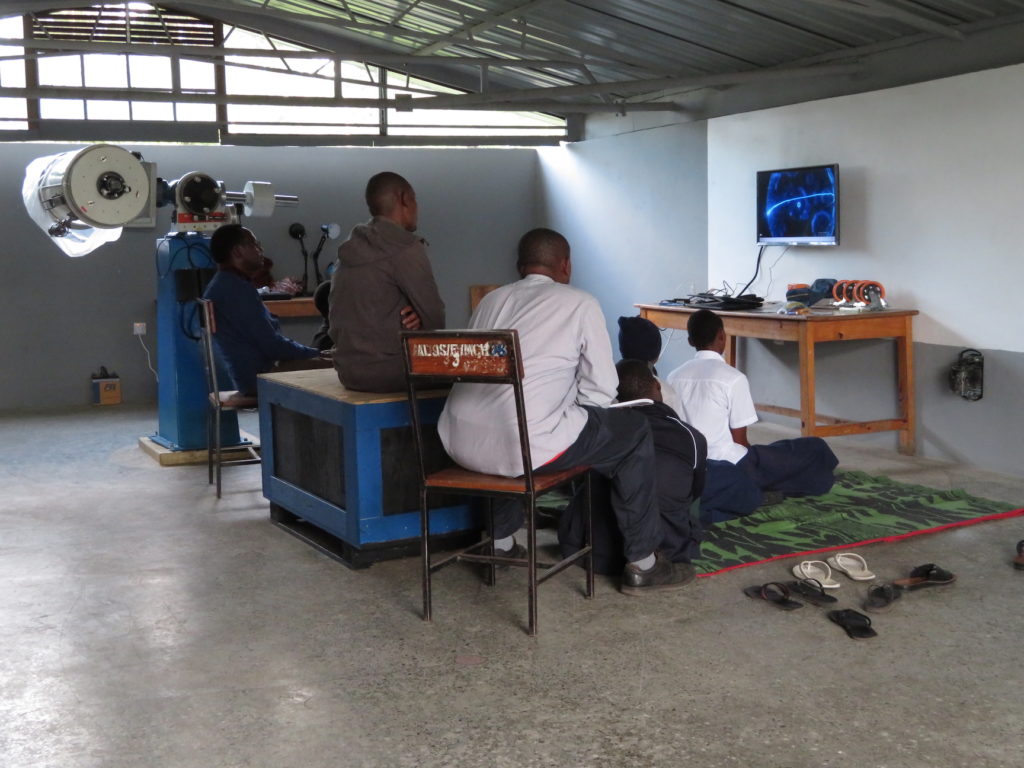
Movie nights at the Mt. Meru Astronomical Observatory!
We are watching the COSMOS series with Neil deGrasse Tyson. For the first episode we enjoyed the company of four Ambassadors to the observatory and a dozen students, all but one girls. Last night, we had standing room only with more than sixty students in the Observatory. It was awesome!
The first episode tells the story of Bruno, a priest who conceived of a universe far larger than that accepted in his time. He shared his vision for the Sun at the center of our solar system, and many other suns with worlds like our own. In this vision, he celebrated the Creator as that of a much larger, much more dynamic universe than simple celestial spheres. For his refusal to recant, he was burnt alive by the Inquisition.
This opened a powerful, engaging conversation for why those in power are often afraid to lose their position, from government leaders to local politicians to teachers too.
The second half places the history of the universe on a one year calendar, from Big Bang to the evolution of the human species in the final one minute. This invoked a series of questions about the birth of stars and formation of solar systems and planets.
The second episode was entirely about evolution, starting with the domestication of wolves to become every breed of dog today, and then a whirlwind tour of the “tree of life”, mass extinctions, and our own shared ancestry with chimpanzees. While the students do learn about evolution in this local school, it is primarily taught as a function of history, not a function in motion now.
I gave examples of evolution as we see it in hospitals across the world with “super bugs” and growing resistance to antibiotics. We discussed our own species as one of the most homogeneous on the planet, all of us nearly identical despite the incredible diversity of our visual appearance as s function of gene expression, not divergence of the DNA itself.
Zacharia, an Ailanga teacher and Astronomy Ambassador and I fielded the questions proposed by the students, for a conversation that could have easily continued to the midnight hour.
My favorite part of that evening was when Carl Sagan’s original 40 second animation of the evolution of species, from single cell organisms to homo sapiens caused everyone in the room to gasp. The resulting questions ranged from “Is there any species that is not evolving now?” to “Are viruses living or dead?”
This is exactly why we pursue astronomy as an entry to science education—it invokes questions about physics, biology, chemistry, and the evolution of life itself.
The high-noon alignment test
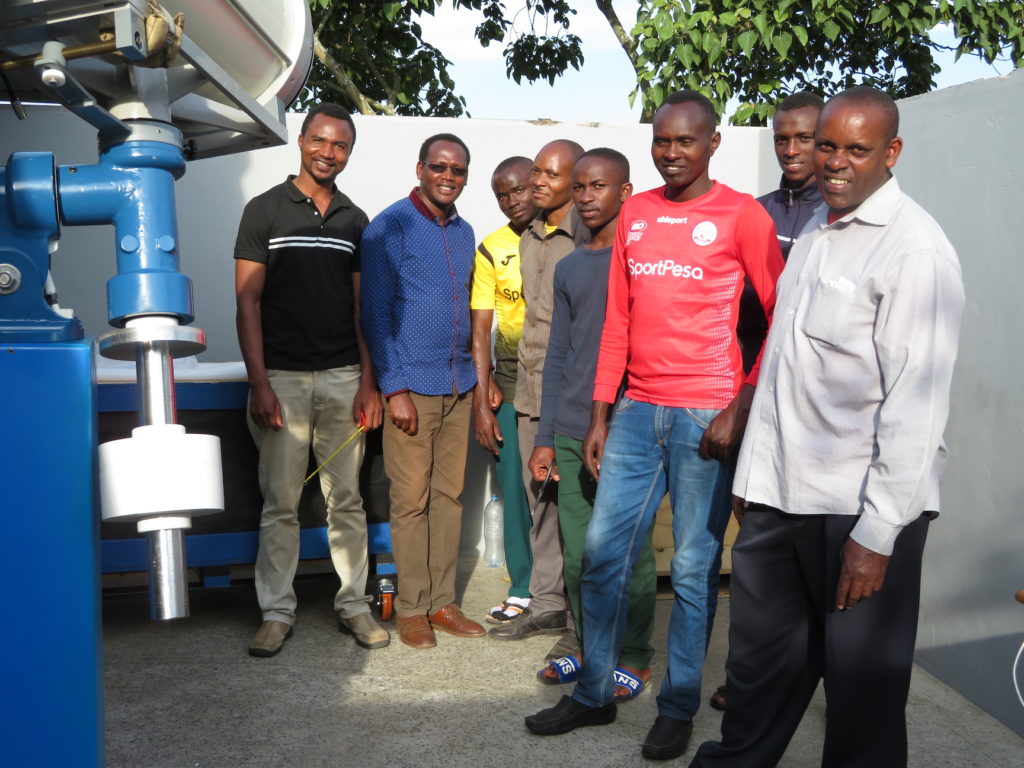
With my family Lindah and her son Liam, Bernard and Truphena again in their home in Nairobi Kenya, I returned my focus to the setting the telescope in its final position. I was joined by Telescopes to Tanzania Ambassadors Eliatosha, Elineema, Eliona, Pendaeli, and Zacharia, and Ailanga students David and [need to recall names] for this effort.
While we had three times before attempted to find polar north using “high noon” and the shortest shadow of the sun as defined by the Heavens Above website, we feel it is important to obtain this vector by our own accord. However, after three weeks we have not been granted a full hour of sun thirty minutes before and thirty minutes after the calculated high noon of 12:38-12:40 pm.
Once again we set our home built sundial (broom stick mounted on a sheet of plywood, bailing twine in tension holding the vertical position) and made certain it held 90 degrees all around.
We waited with pen and tape measure in hand … and waited … and were able to obtain six readings from 12:21 to 12:56 pm, but were missing those needed at the crucial 5 minutes to either side of 12:38 pm.
Between measurements, we conducted a series of linear approximations, starting both before (under) and after (above) the desired 12:38 pm, resulting in 0.9-1.1 mm change in the length of the shadow per minute. We fully understand that this is not a linear function, rather that of a parabolic arc, but for this brief period we were able to determine if 12:38 was likely to have produced the shortest shadow.
As we found the rate of change of the shadow to be similar both before and after the estimated high noon, we decided to fix the base of the telescope on a line parallel to that of 12:38, as captured the day prior.
We then spent nearly two hours leveling the telescope, using metal bars and washers as shims. The result is the top of the steel pedestal to be level within 0.1 degrees on all four sides, and exactly 90 degrees on the south face (the other faces are those of a trapezoid as the pedestal is wider at its base than the top).
If I could recall the names of my geometry and trigonometry teachers, I would reach out to each of them with deep gratitude, for nearly every theorem I memorized has come into play this past two weeks. But it is the Ailanga students who have come to the rescue with fresh recollection of the proper calculations for missing angles using sin and cos functions.
We carefully reassembled the telescope (for the fourth time). At the point of attaching the head we realized we had no easy way to make certain the head was parallel to the newly oriented base. We estimated, at first, but once the weights were attached, realized we could use the distance from the edge of the weights to south face of the pier as the Dec arm to provide a nearly perfect parallel identity.
However, last night we noted a drift in what appears to be both the Dec and RA. Before we shut down the observatory, we measured the equatorial axis alignment, and it had sunk from 3.3 to 3.0 degrees, the effect of the metal settling under the burden of the mass of the full assembly. Today we will easily correct this angle and tonight determine if our drift is reduced.
We now have two spotting scopes, one a battery powered “bull’s eye” without magnification, and the other an Orion magnified spotting scope with cross hairs. Both are now aligned with the primary tube, only a minor adjustment to be performed tonight for spot-on accuracy.
TV, whiteboard hung; prep for final high-noon test
Not much to report this past two days, as I was mostly away from the observatory spending time with my visiting daughter and son from Kenya.
We got the TV and whiteboard hung and disassembled the telescope again to perform what we hope to be the final high-noon drop shadow test to determine polar north and south. With this, we will align the base of the telescope, set the bolts once and for all, and then make fine adjustments with the head.
But alas, no sun at noon for several days. Maybe our luck will change on Sunday …
Cleaning, rebuilding, aligning
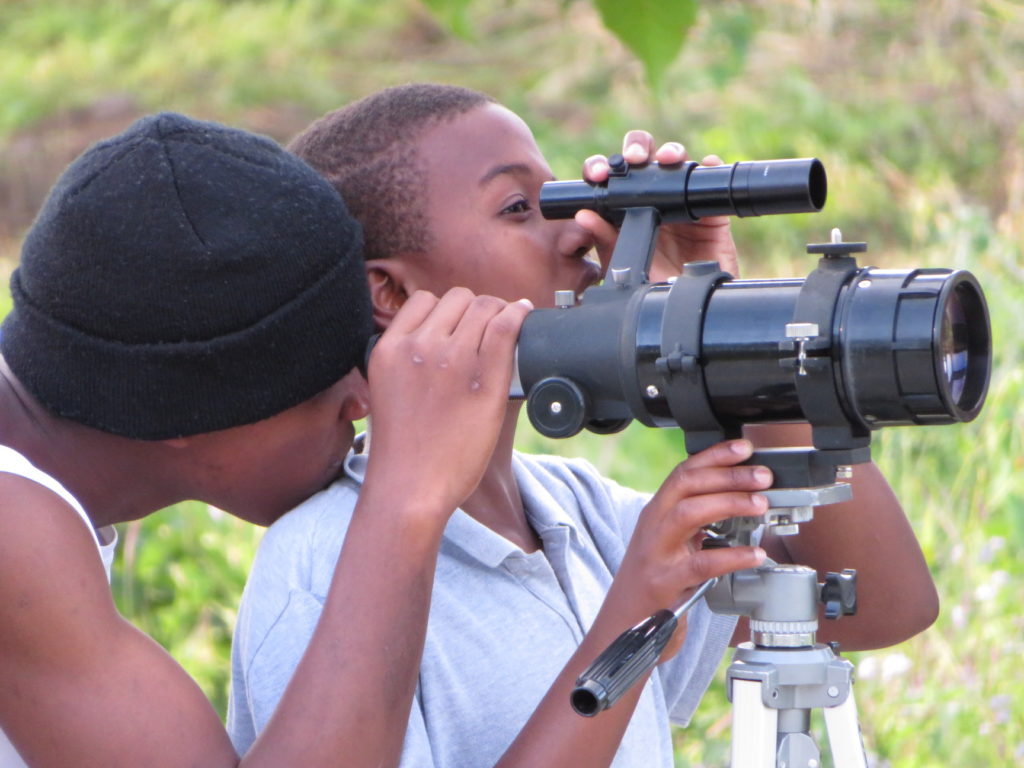
Yesterday saw a multitude of tasks. I worked with students to mark the spots on the wall West wall where the new TV and white board will be mounted. Another group working with Ambassador Eliatosha disassembled an AWB Galileo reflector telescope, cleaned the primary and secondary mirrors, and reassembled it fully while another, in parallel, cleaned and rebuilt a Celestron refractor.
It is imperative to take note that none of these students have ever done anything like this before, most having never used a hex wrench or screwdriver. Without instruction, without any guidance on my behalf (other than how to clean mirrors with distilled water, and lenses with a special cloth), they were 100% successful. The capability of this next generation of Tanzanian’s is extraordinary. To not grant them to use their minds to the fullest is to waste a generation.
Ezikiel, Eliona, and I continued our work on aligning the base (as we have known it was not correctly installed). We spent most of the day transposing and comparing two triangles that share a common hypotenuse, built from the shadow of the sun at zenith (“high noon”). This method for finding polar north can be done by building a sundial or using this website (https://heavens-above.com/) to mark the shortest shadow and then lay down a parallel line. The equatorial axis must be parallel to this line, if it is to be parallel to the Earth’s axis.
We yet have quite a bit of work to do before this observatory is considered operational and the Ambassadors can be fully trained.
Our First Visitors and Third Night for Observing
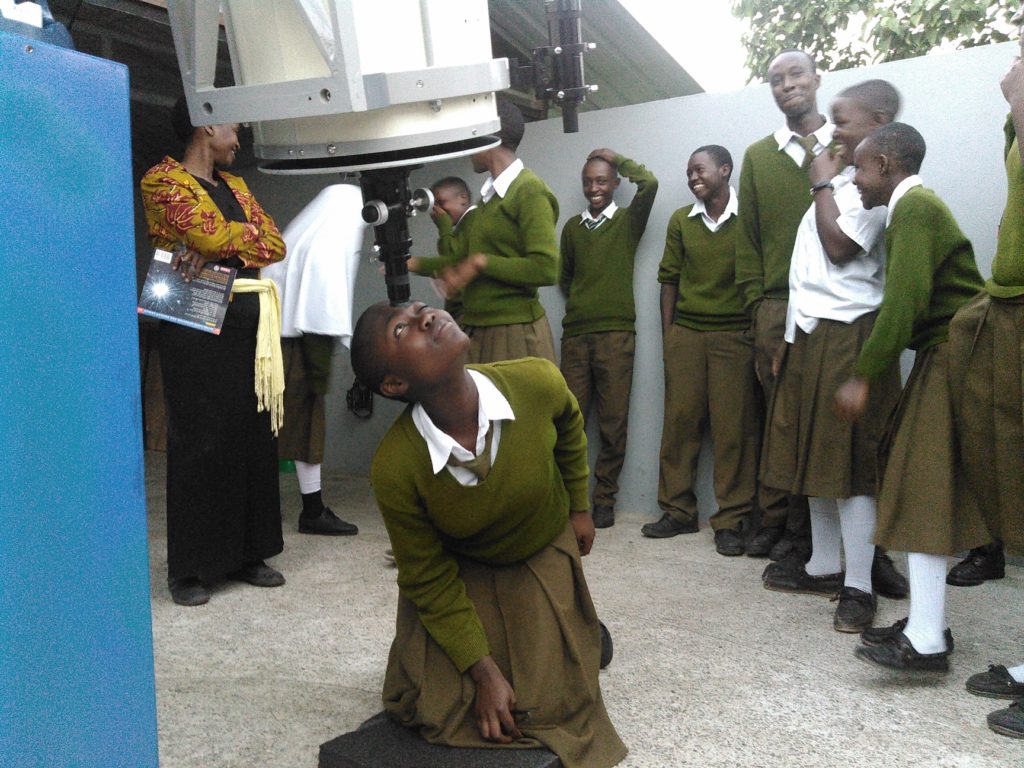
Last night Mr. Miley and his Form Four class of the Ngongongare Secondary School visited the observatory.
Following Miley’s introduction the observatory and the use of a telescope, I provided a lecture for the 3 axes of the equatorial telescope and the function of the concave and convex mirrors in our primary telescope. I asked the students to calculate the rotational velocity of the Earth, given its circumference and then we moved into conversations about why we cannot feel the Earth spinning as compared to that of, say, riding on a bus or airplane.
We spent some time discussing kinetic energy (the students were well versed in this given their physics class) and how a small object traveling a hit speed can cause as large an impact crater as a large object traveling at a lower speed. I provided some experiments they can perform at the school using thick mud and rocks or a cake pan, flour, and small objects flung at various velocities.
We welcomed the presence of Mr. Marike, a member of the Board of Directors for the Organization for Science, Education, and Observation (OSEO) that is responsible for the management of this observatory. Karibu sana!
An hour before sunset, we observed the waxing crescent Moon. Later, some students from Ailang arrived and we tested our CCD camera again, this time with the RA motor spinning in the correct direction (it has been set to the Northern hemisphere, but was easily rectified with the movement of a jumper on the motherboard –thank you Alan!). We observed Jupiter and Saturn, both through a 40mm eyepiece and the computer screen. Stunning!
Second Night for Observing!
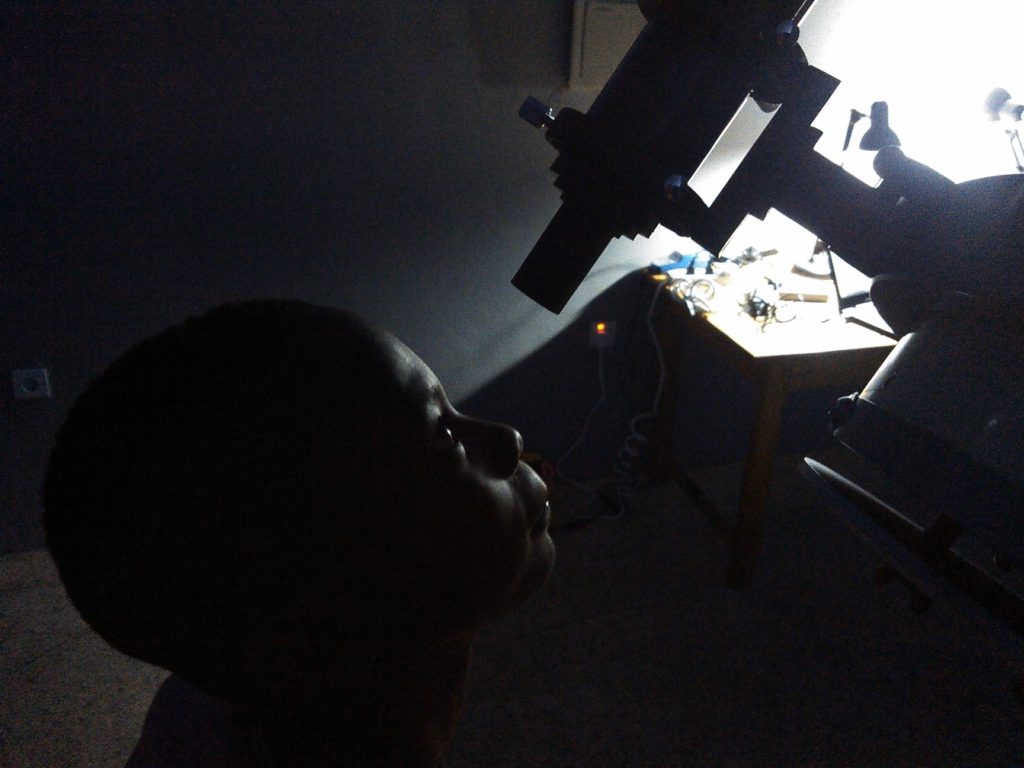
Last night we engaged our second observing session at the Mt. Meru Astronomical Observatory, from 7-10 pm. Again, we enjoyed a full house, with what was easily 60 or more students. This time both boys and girls from the Ailanga secondary school (and the boys were clearly more well behaved 🙂
We introduced three additional telescopes, two mounted on a table, one on a tripod. With these, the students engaged in their own exploration of the night sky overhead.
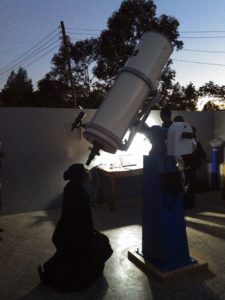 First, we observed the Moon as we had Saturday night. After everyone had a turn, we stopped to discuss what we saw, what we know about the regolith, gravity, cratering on the near and far sides, and presence of frozen water at the poles.
First, we observed the Moon as we had Saturday night. After everyone had a turn, we stopped to discuss what we saw, what we know about the regolith, gravity, cratering on the near and far sides, and presence of frozen water at the poles.
I then asked for volunteers who wanted to point the 12″ telescope at Jupiter. But before this, we discussed why the planets all lie on the plane of the ecliptic, and how that drastically narrows the area of the sky in which to search for them. Without using a sky map, the students surveyed the sky with their eyes and selected just one object before they found Jupiter.
Two of the students then guided the 12″ for the first time, using the tube, spotting scope, and ultimately the eyepiece to learn if their selection was indeed the famous, stormy planet. Finally, we observed Saturn with its glorious rings. And it put on a beautiful show for us this evening. The students commented, “It looks just like the photos in the books!”
In addition, we used out CCD camera for the first time. It worked! but needs some fine-tuning of color, contrast, and focus before the images are worth publishing.
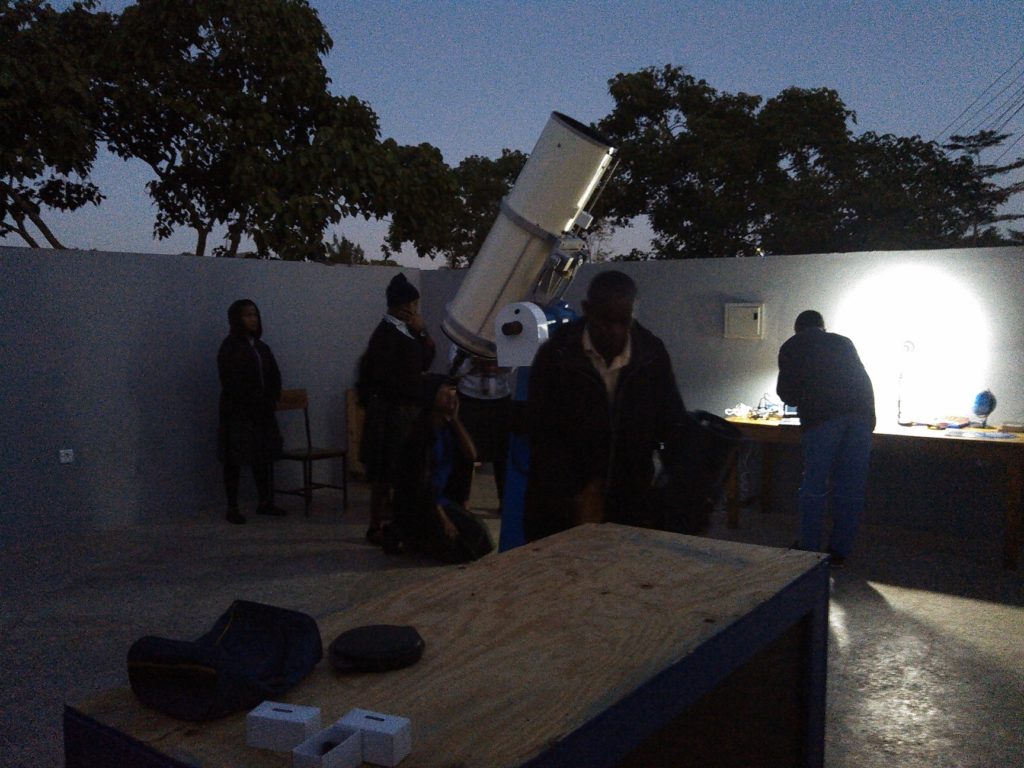
First light!
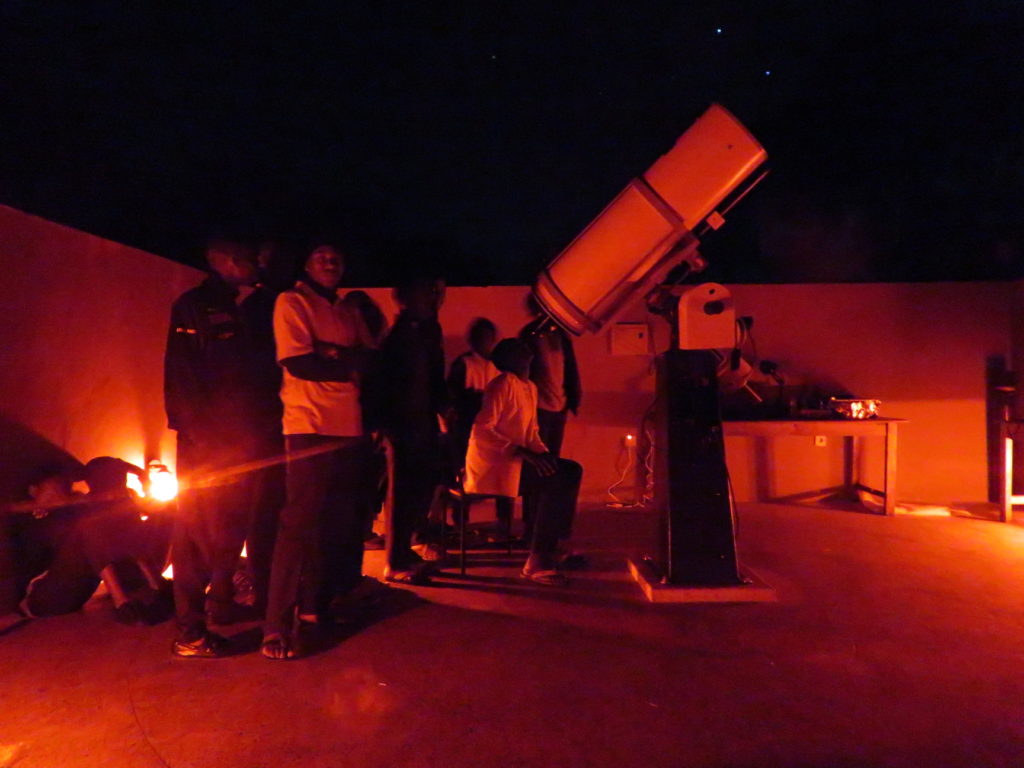
We saw first light!
Today was a whirlwind of activity, with more than 40 students actively engaged at the observatory from shortly after noon ’till well after 10 pm. I juggled management of a half dozen projects, all perfectly executed by the students and two of our ambassadors-teachers.
Today we got the drive motors mounted and the cables attached to the base after thorough testing of all possible directions the telescope moves. One student group built the cap for the telescope tube from the high density, shipping crate foam while another painted the shipping crate that now serves as our workbench on wheels.
We even took a break to make a pinhole camera with hope to indirectly observe the surface of the sun. It didn’t work so well, but it inspired interest to build a solar observatory. That will be our first research project, once the internet is up and running.
A group of a dozen students dove into the vast array of books and science journals shipped with the telescope, asking wonderful questions about the content they were learning while another wrote a series of questions on the white board, which I answered for the large assembly.
“What is the Moon?
“How does one select a new telescope?”
“Does looking through a telescope have any positive or negative affects on the viewer?”
And then an entire array of questions about life on other planets, where humans and robots have explored, and where we hope to go in the future. It was thrilling!
Dusk came quickly, 6 pm before anyone was ready. We were still setting the cover to the RA gear box and I had to run back to my lodge to get fresh batteries for my headlamp. Power was out but the telescope ran perfectly from the charged car battery.
The students ran down the hill from the school to the observatory, passing me as I returned to a gorgeous crescent Moon and Jupiter overhead. We adjusted the position of the secondary mirror to enable focus, aligned the spotting scope, primary telescope, and in a few minutes had a crystal clear image of the Moon.
When I exclaimed, “I’ve got it! Our first view with our telescope!” the entire assembly erupted in cheers and clapping, then preceded to nearly knock me over as they formed a telescope viewing mob. Over the course of the next hour, everyone was able to see the Moon twice. Then we set out sight (literally) on Jupiter. Again, everyone had a chance to view just before the clouds set in.
I was able to grab a photo with my cell phone of the Moon, but not Jupiter as the clouds set in too quickly. Our next goal is to get the CCD camera configured and ready to capture photos.
The only bad news is that the RA motor, when in Guide mode (tracking) appears to be set for the Northern hemisphere and is running the wrong direction. I reached out to the engineer in England who built it for us, asking if we can reconfigure on site. Stay tuned!
A re-balancing of the 12″ Cassegrain telescope
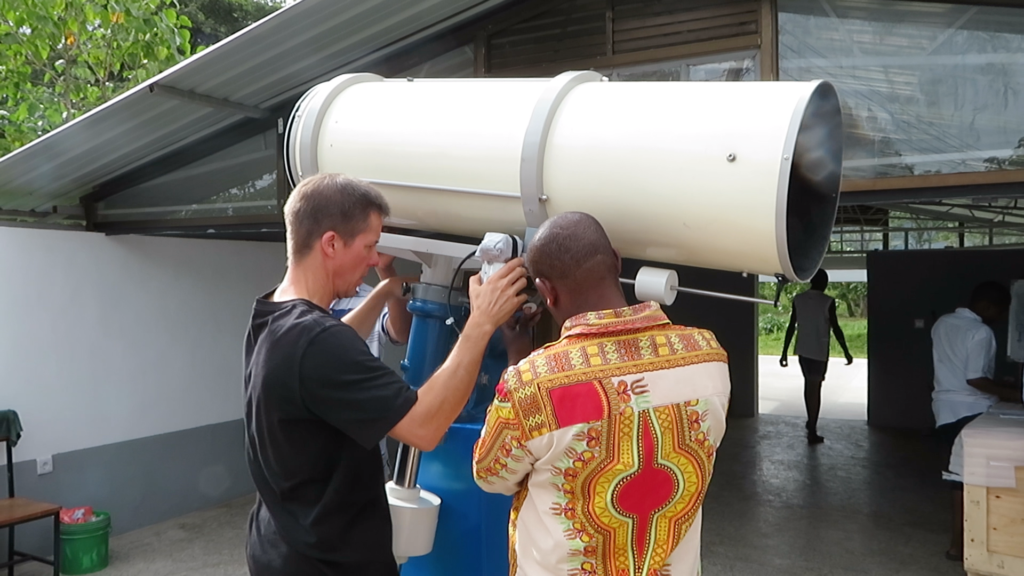
In this short video, Kai, Zacharia, and Eliona with the students of Ailanga school work to balance the 12″ Cave-Cassegrain telescope on both the declination and right ascension axes before mounting the motors.
